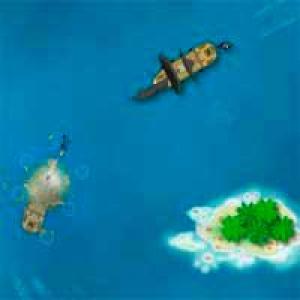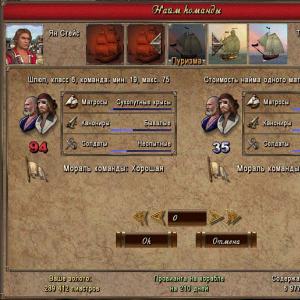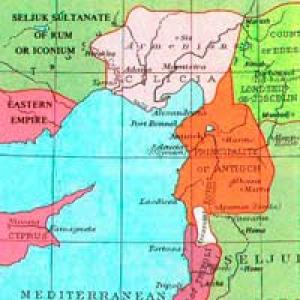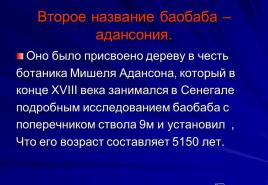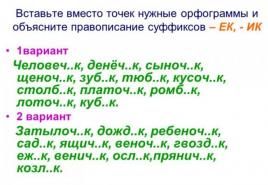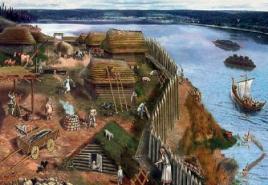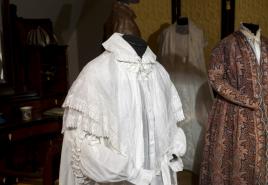"Queen Anne's Revenge" - Around the World - Virtual Travel Magazine. Edward Teach's ship - "Queen Anne's Revenge" Concorde ship
In November 1717 Edward Teach by nickname Blackbeard captured a French slave trading ship off the coast of Saint Vincent and made it his flagship. The ship's original name was (Concorde) and was a 14-gun French merchant ship with a displacement of more than 200 tons. By this time, the ship had successfully made three voyages to the shores of Guinea.
Blackbeard named his flagship (Queen Anne's Revenge), probably as a memory of military service during the reign of Queen Anne. Teach gave Pierre Doss, captain of Concorde, his sloop and, in addition, all the slaves he had, with whom he safely reached Martinique.
When the pirates captured the ship, it was a three-masted ship with square sails. In accordance with pirate tradition, starting from practical needs, Teach remade the ship. He cut additional gun ports and added 26 more to the 14 existing guns. Apparently, he needed an additional gun platform and, unlike most pirate ships, Teach did not touch the quarterdeck, onto which he managed to squeeze about 10 guns. Finally, Blackbeard cut off the tank, thus revealing the cannons that stood there. Apparently to create additional firepower, the pirates installed swivel guns on the poop along the gunwale, the exact number of which is unknown. From archaeological finds it should be concluded that there were at least four cannons on each side. With 40 cannons on board, Teach had some of the strongest ships in American waters, and he was able to take full advantage of his ship's capabilities. The only one  a pirate ship, larger in size than Tich's ship, was the ship Royal luck
(Royal Fortune) Bartholomew Roberts. Ship owners recruited too few crews for merchant ships, skimping on sailors' wages and provisions. For example, on board a 180-ton ship that perished in 1700 off the coast of Florida Henrietta Mary
(Henrietta Marie), engaged in the transportation of slaves, had a crew of only 20 people, and was armed with eight 3/4-pounder guns. As a rule, pirate ships had an overwhelming numerical superiority over any merchant crew. Even a small pirate sloop with a crew of 30 people could board a large merchant ship. And when meeting with a ship like
, the merchant ship had no chance of salvation. Large pirate flagships required a large crew. In Her Majesty's Royal Navy at the beginning of the 18th century, a 40 or 50-gun ship of the 4th rank had a crew of 250 people. The crew of one gun consisted of 6/8 people. Even if we take into account that the ship was firing from only one side at a time, it becomes clear that only individual sailors controlled the ship in battle. For pirates, this ratio was approximately the same, and in addition to the gunners, the crew also included members of the boarding party. Merchant ship captain who survived the attack Blackbeard in December 1718, in his report he reported to the colonial authorities: The pirate ship was a ship of French slave traders, its armament consists of 36 cannons, the ship’s crew is very large, apparently three hundred. The pirates apparently do not experience any shortages of provisions.
a pirate ship, larger in size than Tich's ship, was the ship Royal luck
(Royal Fortune) Bartholomew Roberts. Ship owners recruited too few crews for merchant ships, skimping on sailors' wages and provisions. For example, on board a 180-ton ship that perished in 1700 off the coast of Florida Henrietta Mary
(Henrietta Marie), engaged in the transportation of slaves, had a crew of only 20 people, and was armed with eight 3/4-pounder guns. As a rule, pirate ships had an overwhelming numerical superiority over any merchant crew. Even a small pirate sloop with a crew of 30 people could board a large merchant ship. And when meeting with a ship like
, the merchant ship had no chance of salvation. Large pirate flagships required a large crew. In Her Majesty's Royal Navy at the beginning of the 18th century, a 40 or 50-gun ship of the 4th rank had a crew of 250 people. The crew of one gun consisted of 6/8 people. Even if we take into account that the ship was firing from only one side at a time, it becomes clear that only individual sailors controlled the ship in battle. For pirates, this ratio was approximately the same, and in addition to the gunners, the crew also included members of the boarding party. Merchant ship captain who survived the attack Blackbeard in December 1718, in his report he reported to the colonial authorities: The pirate ship was a ship of French slave traders, its armament consists of 36 cannons, the ship’s crew is very large, apparently three hundred. The pirates apparently do not experience any shortages of provisions.
Peaks of success Blackbeard reached in May 1718, when he managed to blockade the port of Charleston on the coast of South Carolina. Local residents reported: The squadron under the command of Teach himself consisted of a 40-gun ship and three sloops. The total number of crews exceeded 400 people.
The next month, he led to Topsail Bay, currently located here is the city of Beaufort (North Carolina). Here his flagship ran aground.
In 1997, archaeological work began at the site of the shipwreck. The debris is located at a depth of 7 meters. At the moment, scientists have discovered the remains of the ship itself, naval artillery (21 cannons) and ship accessories. The discovered guns were made in different countries, although the majority were made in England. The archaeological team hopes to continue the work. Musket balls, cannonballs and small arms recovered from the wreck indicate that the ship was exceptionally well armed. A ship's bell dating back to 1705, a lead syringe and other finds were discovered at the shipwreck site.
Recent archaeological research allows us to confidently say about naval artillery. Most of the pirate ship cannons were British made, cast at Wheeldon, Sussex. Among the cannons, 5 were cast in other countries, primarily in France. All non-English cannons were cast iron. Bronze cannons by that time were rare and expensive. The reliability of cast iron cannons increased noticeably in the second half of the 17th century, so bronze cannons began to fall out of use. If there were bronze cannons on the ship, they were placed in the area of the ship's compass so that large masses of iron would not interfere with the operation of the device. In addition to cannons, the arsenals of pirate ships were filled with a variety of small arms, gunpowder and hand grenades.
The image of the ship is actively used in modern films about the pirate era, for example, in the fourth part Pirates of the Caribbean: On Stranger Tides .
Ship reconstruction
1. Stern light. 2. Blackbeard's flag. 3. Mizzen yard. 4. Rhea. 5. Mizzen mast. 6. Mainmast. 7. Utah deck. 8. Quarterdeck. 9. Mignon (4 pounds). 10. Additional gun port. 11. Swivel cannon (1 pound). 12. 8-pounder gun. 13. Saker (6 pounds). 14. Deck beams. 15. Waist. 16. Main gun port. 17. Cut tank. 18. Foremast. 19. Sprint topsail. 20. Bowsprit. 21. Place of the figurehead (lost in a storm even before the ship was captured by pirates). 22. Cat-beam. 23. Nose. 24. Anchor (one of three). 25. Coil of cable. 26. Capstan. 27. Crew quarters. 28. Cockpit hatch. 29. Ballast (stones and spare gun barrels). 30. Water supplies. 31. Hold (archaeologists found traces of golden sand here). 32. Locker with ammunition. 33. Crew chamber. 34. Pump. 35. Ladder. 36. Capstan. 37. Rum storage and arsenal. 38. Dried food warehouse. 39. Captain's cabin. 40. Blackbeard's cabin. 41. Aft windows. 42. Stern gallery.
Added: 01/17/2012
Queen Anne's Revenge. Model from the North Carolina Maritime Museum
Queen Anne's Revenge
Thanks to the vigorous activity of the film industry, this ship has recently become widely known even in circles far from historians of sea piracy. However, unlike other ships of the pirate epic, Queen Anne's Revenge is a real ship, the flagship of the well-known pirate Edward Teach or Edward Thatch, nicknamed Blackbeard.
To be fair, it must be said that Blackbeard, as a fictional character, became widely known long before Pirates of the Caribbean. Both D. Defoe and Stevenson (the prototype of Flint) wrote about him. This is not to mention the countless myths and legends.
Everyone knows "...fifteen people for a dead man's chest...".
More correctly, “...on Dead Man’s Chest...” - an island in the Caribbean Sea measuring 200 square meters. meters, where, according to legend, Teach landed 15 people from his team, who rebelled against the cruelty and extravagance of the captain. Having provided them only with sabers and rum - a bottle per brother - Blackbeard hoped that the rebels would go crazy from thirst, hunger, heat and kill each other.
The legend says - everyone survived.
By the way, the English “Yo-ho-ho” is not our “O-ho-ho”, but rather “One-two-take”
 Edward Teach, Antique engraving
Edward Teach, Antique engraving
Edward Teach (real name Edward Drummond) was born in England around 1680. During the Anglo-French "Queen Anne's War" (1702-1713) he traded in privateering, and later joined Benjamin Hornigold, who robbed French and Spanish ships in Caribbean Sea.
Queen Anne's Revenge was previously a three-masted French ship, La Concorde, whose crew was actively involved in the slave trade.
In November 1717, a detachment of pirates under the command of Blackbeard on 2 small sloops captured Concord, a well-armed 300-ton ship.
A little later, when Hornigold, in the hope of an amnesty, retired, Blackbeard led the pirates who joined him, making Concorde his flagship and renaming her Queen Anne's Revenge. According to eyewitnesses, it was a ship that had excellent seaworthiness, initially having 26 guns, it was re-armed by Tich and carried up to 40 guns and 150 crew.
By the way, during the expropriation of Concord, the French suffered only “financial and moral losses” - they, along with their slaves, were landed on the nearest shore and, moreover, one of the pirate sloops was allocated to them as compensation.
 Restored cannon. Exhibit at the North Carolina Maritime Museum
Restored cannon. Exhibit at the North Carolina Maritime Museum
1717 and almost all of 1718 were very successful for Blackbeard - his flotilla grew to 4 ships (another famous ship of Edward Teach - "Adventure"), the crew numbered more than 300 pirates. They robbed over 40 ships, undertook coastal raids and naval blockades (the famous blockade of Charlestown in South Carolina). However, by this time, the governors of the Bohamian Islands and especially Virginia were taking a number of measures to combat coastal piracy.
In June 1718 Queen Anne's Revenge ran aground and then sank in Topsail Bay - the area of present Beaufort Inlet. According to one version, Blackbeard tried to hide from his pursuers in secluded places in North Carolina and could not cope with the difficult shipping situation in this water area. According to another, Teach intentionally ran the ship aground, because... After this incident, abandoning his crew, he disappeared with a small group of pirates and all the loot on a small sloop. And he no longer needed Queen Anne's Revenge herself, since she was too noticeable and too famous in these waters.
In the summer and autumn of 1718, Blackbeard undertook a number of pirate forays, but on November 22, English Lieutenant Robert Maynard, hired by the Governor of Virginia, Spotswood, overtook Teach's ship. The pirate leader was killed in hand-to-hand combat.

Exactly 278 years later, on November 22, 1996, a rusted anchor was discovered under water in the Beaufort area, and then the remains of an ancient ship. Subsequent underwater work and laboratory studies of artifacts raised from the bottom allow us to assert with increasing confidence that the found ship was precisely Queen Anne's Revenge - Queen Anne's Revenge(although a huge number of ships and vessels - several hundred! - were wrecked in these waters at various times)
Work on this find continues to this day. Underwater research, laboratory research, work in archives... And as usually happens in such cases, a new discovery gives rise to new questions...
What did he look like? La Concorde - Queen Anne's Revenge?
The answer to this question has not yet been found. However, it is unlikely that his appearance corresponded to the cinematic one. Researchers such as David Moore, an employee of the North Carolina Maritime Museum, prefer an image more consistent with that presented in the monograph by J. Boudriot (J. Boudriot Monographie LE MERCURE - Navire marchand 1730)
If you would like to keep up to date with the latest research developments Queen Anne's Revenge We recommend visiting the site
Queen Anne's Revenge is the universally recognizable name of the great pirate's ship. On this ship the famous filibuster reached the climax of his pirate career. The capture of this ship, previously called the Concorde, occurred in 1717; until that moment it was a merchant, 14-gun French ship, with a displacement of slightly more than 200 tons. It is not known for certain why Teach gave the ship such a rather strange name; according to one version, it was a tribute to the memories of the past, because earlier, during the reign of Queen Anne, Edward was in military service.
After the capture, Teach showed a rare and unusual good nature for him in the future: he gave the captain his sloop and all the slaves he (Teach) had at that time, with whom the would-be captain successfully reached the waters of Martinique.
Renaming the ship to " Queen Anne's Revenge"was only a small part of the ship's upcoming changes. Blackbeard cut additional holes for the cannons and increased their number in total to 40 pieces! Even a small group of pirates on a schooner instilled fear in merchant ships, let alone a bloodthirsty robber, whose ship was second only in firepower.
The Siege of Charleston in May 1718 is Captain Teach's most famous moment of success on the Queen Anne's Revenge. The end of the famous ship was not a great naval battle, but a banal ship running aground in June 1718 off the coast of North Carolina.
In April 2012, archaeologists made a statement about the discovery of a vessel that was planned to be raised from the seabed in the future.
Reconstruction of Blackbeard's pirate ship

1. Stern light. 2. Blackbeard's flag. 3. Mizzen yard. 4. Rhea. 5. Mizzen mast. 6. Mainmast. 7. Utah deck. 8. Quarterdeck. 9. Mignon (4 pounds). 10. Additional gun port. 11. Swivel cannon (1 pound). 12. 8-pounder gun. 13. Saker (6 pounds). 14. Deck beams. 15. Waist. 16. Main gun port. 17. Cut tank. 18. Foremast. 19. Sprint topsail. 20. Bowsprit. 21. Place of the figurehead (lost in a storm even before the ship was captured by pirates). 22. Cat-beam. 23. Nose. 24. Anchor (one of three). 25. Coil of cable. 26. Capstan. 27. Crew quarters. 28. Cockpit hatch. 29. Ballast (stones and spare gun barrels). 30. Water supplies. 31. Hold (archaeologists found traces of golden sand here). 32. Locker with ammunition. 33. Crew chamber. 34. Pump. 35. Ladder. 36. Capstan. 37. Rum storage and arsenal. 38. Dried food warehouse. 39. Captain's cabin. 40. Blackbeard's cabin. 41. Aft windows. 42. Stern gallery.
121. Triangle (3)
Everyone knows about the Bermuda Triangle. From time to time someone disappears there. Mulder believes that the reason for this phenomenon lies in the narrowing of time bands. Thus, disappeared objects move not in space, but in time. The Lone Gunmen seem to be on board with this idea as well. They monitor this region through Google Map (if such a resource already existed in 1998). And now, in real time, they see that the satellite has detected the Queen Anne ocean liner, which went missing in 1939, in the Triangle. They send the coordinates to Mulder, who voluntarily leaves work, flies to Florida, hires a boat there and rushes to the place where the Queen Anne appears. The Lone Gunmen monitor the boat via satellite. But then a storm broke out... and Mulder disappeared from communication.
Further, the action develops in two parallel realities. Mulder was pulled out of the wrecked boat by the Queen Anne's sailors. He is happy: not because he was rescued from the depths of the sea, but because he saw guests from the past. However, as it turned out, it was he - a guest from the future. Everywhere - September 1939, and all the radio stations are talking about the recently broken out war, which does not yet promise to become a world war: the Russians, in collusion with Hitler, are fighting off Poland among themselves, and the rest of the countries are silently watching. But hatred of the Nazis had already formed among ordinary people. “Why do they hate us Germans so much? - the fascists are perplexed, landing on board the Queen Anne (Russian tourists are now increasingly asking this question) - we’re not at war with Great Britain, are we?
But the Germans are here on business: they are looking for Professor Thor Hammer, who can invent an atomic bomb. And the fascists are kind of strange: the Chief Navigator-Führer is the spitting image of the Smoker, his deputy looks like Skinner, and the Smoker’s lackey looks like an FBI agent, his son. But Mulder meets Scully among the passengers. She is on a secret mission to protect the professor.
While Mulder is trying to persuade the crew to go to America so that history continues to take its course and the Germans do not get an egghead who would make a bomb for them, the real Scully, in 1998, is trying to find the coordinates of the crash of Mulder's boat and the Queen Anne that suddenly appeared. After much worry, she gets it - Skinner helps her.
Scully and the Lone Gunmen get there, and indeed, they see an ocean liner. The lights are on, but people's voices are not heard. They board the Queen Anne. This is a ghost ship: everything is new, but no one is alive. All life is in a parallel reality. There, in 1939, the crew escaped from a closed hold and attacked a detachment of Nazis. The passengers provided the sailors with warm and effective support. While everyone was fighting in the restaurant, Mulder and a passenger who looked like Scully were running around the decks, and the SS men were chasing them. One almost caught up, but a German who looked like Skinner, who turned out to be a spy, shot him. Eventually, Mulder decides to get off the Queen Anne and jumps overboard. Before the jump, he kisses the passenger and gets punched in the face by her.
Time connects again. Fox, unconscious, is dragged aboard the Lone Gunmen. Mulder comes to his senses in 1998 and begins to talk about his adventures. And he confesses his love for Scully. Fox is destined to be considered a nutcase: he was considered a nutcase in 1939, and in modern times too. Scully didn't even respond to the confession of love and left. But Mulder's cheek, where it was slapped, still ache pleasantly.
There are many legends surrounding pirate activities, which developed widely in the Middle Ages: which of them is true and which is fiction - let historians figure it out. But it should be noted that despite the fact that many details of pirate life still remain unknown, some evidence of the deeds of the gentlemen of fortune was still found. And one of them is the ship of the legendary pirate (Edward Teach), which was called Queen Anne's Revenge.
The beginning of the history of the great flagship
The flagship ship was built back in 1710. It was originally called Concorde. And first it was used by the Spaniards. However, the French soon bought the ship, and its last owner, who gave the ship worldwide fame, was Edward Teach, a cruel pirate who terrified sailors with just his name.
In 1717, the Concorde followed its usual route, carrying a crew of French slave traders. Suddenly, two light and fast pirate sloops appeared on the horizon, on board which the pirates were vigilantly looking out for their new victim.
There is an opinion that the French were quite capable of smashing into pieces the boats of the gentlemen of fortune, which were flimsy compared to the Concorde. But each of the crew members had heard about Teach’s tough temper and exorbitant cruelty, so no one wanted to get into battle with the most formidable pirate of that time. At the first order of Blackbeard, the French sailors laid down their arms, after which the ship was captured.
"Queen Anne's Revenge"
The flagship Concorde was renamed Queen Anne's Revenge immediately after Blackbeard took it over and installed his crew of notorious thugs on the ship. It should be noted that the ship was simply huge in comparison with most ships plowing the world’s oceans at that time.
"Queen Anne's Revenge" had three masts, and its length was as much as 36 meters with an 8-meter width. Edward Teach put a lot of effort into improving his new floating home and placed 40 artillery pieces on board. Such power was unheard of even for the Spanish navy, and the ship's capacity was 150 people, who served in Blackbeard's crew.
Within just one year after the capture of the Concorde, Teach captured 4 more ships on the newly renamed ship. Under the command of Blackbeard, who led his escort from the captain's bridge of Queen Anne's Revenge, he carried out about 35 predatory attacks, of which not all were carried out at sea.
In the last years of his life, Teach actively “worked” on land, and at the beginning of 1718 he even led the blockade of Charleston. At the beginning of summer, the ship ran aground near North Carolina. But there is an opinion that Blackbeard led him into shallow water deliberately - by that time, Queen Anne's Revenge was too recognizable to make sudden raids on it.
The sunken flagship on which the legendary pirate sailed was discovered in early 2012. And today, active work is underway to raise his remains from the seabed.

